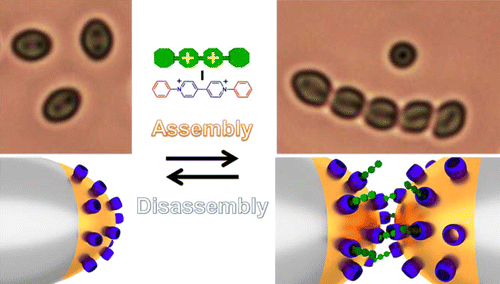Our official English website, www.x-mol.net, welcomes your
feedback! (Note: you will need to create a separate account there.)
Redox-Responsive Viologen-Mediated Self-Assembly of CB[7]-Modified Patchy Particles
Langmuir ( IF 3.7 ) Pub Date : 2016-07-06 00:00:00 , DOI: 10.1021/acs.langmuir.6b01433
Farah Benyettou 1 , Xiaolong Zheng 2 , Elizabeth Elacqua 2 , Yu Wang 2 , Parastoo Dalvand 3 , Zouhair Asfari 4 , John-Carl Olsen 5 , Dong Suk Han 6 , Na’il Saleh 7 , Mourad Elhabiri 3 , Marcus Weck 2 , Ali Trabolsi 1
Langmuir ( IF 3.7 ) Pub Date : 2016-07-06 00:00:00 , DOI: 10.1021/acs.langmuir.6b01433
Farah Benyettou 1 , Xiaolong Zheng 2 , Elizabeth Elacqua 2 , Yu Wang 2 , Parastoo Dalvand 3 , Zouhair Asfari 4 , John-Carl Olsen 5 , Dong Suk Han 6 , Na’il Saleh 7 , Mourad Elhabiri 3 , Marcus Weck 2 , Ali Trabolsi 1
Affiliation

|
Sulfonated surface patches of poly(styrene)-based colloidal particles (CPs) were functionalized with cucurbit[7]uril (CB[7]). The macrocycles served as recognition units for diphenyl viologen (DPV2+), a rigid bridging ligand. The addition of DPV2+ to aqueous suspensions of the particles triggered the self-assembly of short linear and branched chainlike structures. The self-assembly mechanism is based on hydrophobic/ion-charge interactions that are established between DPV2+ and surface-adsorbed CB[7]. DPV2+ guides the self-assembly of the CPs by forming a ternary DPV2+⊂(CB[7])2 complex in which the two CB[7] macrocycles are attached to two different particles. Viologen-driven particle assembly was found to be both directional and reversible. Whereas sodium chloride triggers irreversible particle disassembly, the one-electron reduction of DPV2+ with sodium dithionite causes disassembly that can be reversed via air oxidation. Thus, this bottom-up synthetic supramolecular approach allowed for the reversible formation and directional alignment of a 2D colloidal material.
中文翻译:

氧化还原响应的紫精介导的CB [7]修饰的修补颗粒的自组装。
用葫芦丝[7]尿素(CB [7])对聚(苯乙烯)基胶体颗粒(CP)的磺化表面贴剂进行功能化。大环用作二苯基紫精(DPV 2 +)(刚性桥联配体)的识别单元。在颗粒的水悬浮液中添加DPV 2+会触发短的线性和分支链状结构的自组装。自组装机制是基于DPV 2+与表面吸附的CB之间建立的疏水/离子-电荷相互作用[7]。DPV 2+通过形成三元DPV 2 + ⊂(CB [7])2来引导CP的自组装。复杂,其中两个CB [7]大环连接到两个不同的粒子。紫精驱动的颗粒组装被发现是定向的和可逆的。氯化钠会引发不可逆的粒子分解,而连二亚硫酸钠对DPV 2+的单电子还原会导致分解,这种分解可以通过空气氧化来逆转。因此,这种自下而上的合成超分子方法允许2D胶体材料的可逆形成和方向对准。
更新日期:2016-07-06
中文翻译:

氧化还原响应的紫精介导的CB [7]修饰的修补颗粒的自组装。
用葫芦丝[7]尿素(CB [7])对聚(苯乙烯)基胶体颗粒(CP)的磺化表面贴剂进行功能化。大环用作二苯基紫精(DPV 2 +)(刚性桥联配体)的识别单元。在颗粒的水悬浮液中添加DPV 2+会触发短的线性和分支链状结构的自组装。自组装机制是基于DPV 2+与表面吸附的CB之间建立的疏水/离子-电荷相互作用[7]。DPV 2+通过形成三元DPV 2 + ⊂(CB [7])2来引导CP的自组装。复杂,其中两个CB [7]大环连接到两个不同的粒子。紫精驱动的颗粒组装被发现是定向的和可逆的。氯化钠会引发不可逆的粒子分解,而连二亚硫酸钠对DPV 2+的单电子还原会导致分解,这种分解可以通过空气氧化来逆转。因此,这种自下而上的合成超分子方法允许2D胶体材料的可逆形成和方向对准。































 京公网安备 11010802027423号
京公网安备 11010802027423号